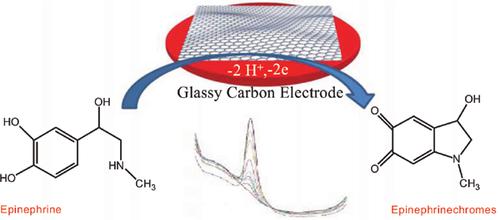Current Analytical Chemistry ( IF 1.7 ) Pub Date : 2020-05-31 , DOI: 10.2174/1573411015666190104110928 Renjini Sadhana 1 , Pinky Abraham 1 , Anithakumary Vidyadharan 1

|
Introduction: In this study, solar exfoliated graphite oxide modified glassy carbon electrode was used for the anodic oxidation of epinephrine in a phosphate buffer medium at pH7. The modified electrode showed fast response and sensitivity towards Epinephrine Molecule (EP). The electrode was characterized electrochemically through Cyclic Voltammetry (CV) and Differential Pulse Voltammetry (DPV). Area of the electrode enhanced three times during modification and studies reveal that the oxidation process of EP occurs by an adsorption controlled process involving two electrons. The results showed a detection limit of 0.50 ± 0.01μM with a linear range up to 100 μM. The rate constant calculated for the electron transfer reaction is 1.35 s-1. The electrode was effective for simultaneous detection of EP in the presence of Ascorbic Acid (AA) and Uric Acid (UA) with well-resolved signals. The sensitivity, selectivity and stability of the sensor were also confirmed.
Methods: Glassy carbon electrode modified by reduced graphene oxide was used for the detection and quantification of epinephrine using cyclic voltammetry and differential pulse voltammetry.
Results: The results showed an enhancement in the electrocatalytic oxidation of epinephrine due to the increase in the effective surface area of the modified electrode. The anodic transfer coefficient, detection limit and electron transfer rate constant of the reaction were also calculated.
Conclusion: The paper reports the determination of epinephrine using reduced graphene oxide modified glassy carbon electrode through CV and DPV. The sensor exhibited excellent reproducibility and repeatability for the detection of epinephrine and also its simultaneous detection of ascorbic acid and uric acid, which coexist in the biological system.
中文翻译:

太阳剥落的氧化石墨烯:肾上腺素的电化学传感平台。
简介:在这项研究中,使用太阳剥落的氧化石墨修饰的玻碳电极在pH7的磷酸盐缓冲液中对肾上腺素进行阳极氧化。修饰的电极显示出对肾上腺素分子(EP)的快速响应和敏感性。通过循环伏安法(CV)和微分脉冲伏安法(DPV)对电极进行电化学表征。在修饰过程中,电极的面积增加了三倍,研究表明,EP的氧化过程是由涉及两个电子的吸附控制过程发生的。结果显示检测限为0.50±0.01μM,线性范围最高为100μM。计算出的电子转移反应的速率常数为1.35 s-1。该电极对于在抗坏血酸(AA)和尿酸(UA)存在下具有良好分辨信号的同时检测EP是有效的。还确定了传感器的灵敏度,选择性和稳定性。
方法:采用还原型氧化石墨烯修饰的玻碳电极,采用循环伏安法和差分脉冲伏安法对肾上腺素进行检测和定量。
结果:结果表明,由于修饰电极的有效表面积增加,肾上腺素的电催化氧化作用增强。还计算了反应的阳极转移系数,检测极限和电子转移速率常数。
结论:本文报道了用还原型氧化石墨烯修饰的玻碳电极通过CV和DPV法测定肾上腺素的方法。该传感器对肾上腺素的检测以及在生物系统中共存的抗坏血酸和尿酸的同时检测具有极好的可重复性和可重复性。









































 京公网安备 11010802027423号
京公网安备 11010802027423号